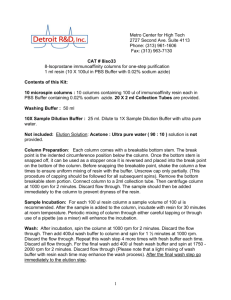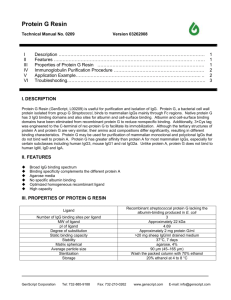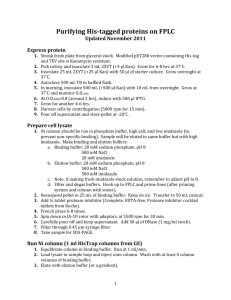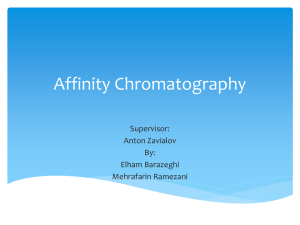AcroSep MEP HyperCel Columns Mixed-Mode Chromatography Columns for Protein Separation
advertisement
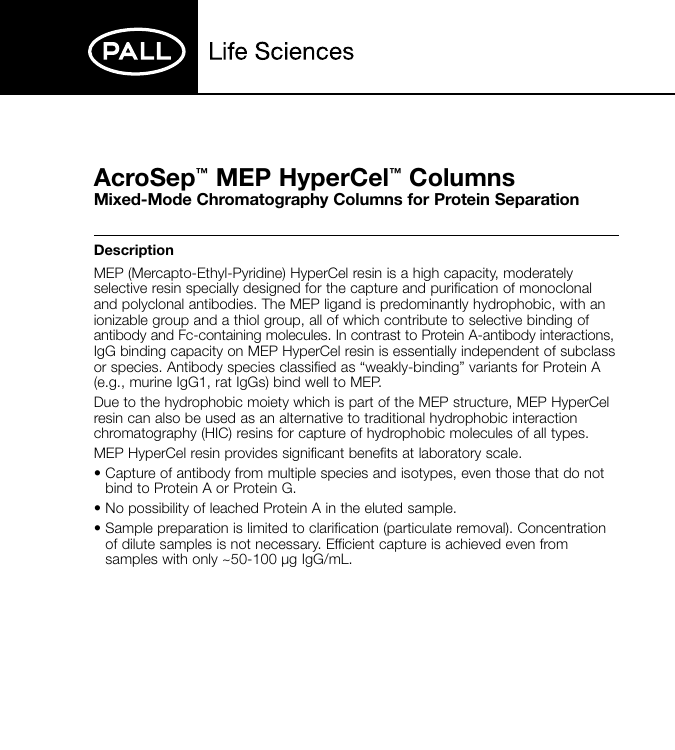
AcroSep™ MEP HyperCel™ Columns Mixed-Mode Chromatography Columns for Protein Separation Description MEP (Mercapto-Ethyl-Pyridine) HyperCel resin is a high capacity, moderately selective resin specially designed for the capture and purification of monoclonal and polyclonal antibodies. The MEP ligand is predominantly hydrophobic, with an ionizable group and a thiol group, all of which contribute to selective binding of antibody and Fc-containing molecules. In contrast to Protein A-antibody interactions, IgG binding capacity on MEP HyperCel resin is essentially independent of subclass or species. Antibody species classified as “weakly-binding” variants for Protein A (e.g., murine IgG1, rat IgGs) bind well to MEP. Due to the hydrophobic moiety which is part of the MEP structure, MEP HyperCel resin can also be used as an alternative to traditional hydrophobic interaction chromatography (HIC) resins for capture of hydrophobic molecules of all types. MEP HyperCel resin provides significant benefits at laboratory scale. • Capture of antibody from multiple species and isotypes, even those that do not bind to Protein A or Protein G. • No possibility of leached Protein A in the eluted sample. • Sample preparation is limited to clarification (particulate removal). Concentration of dilute samples is not necessary. Efficient capture is achieved even from samples with only ~50-100 µg IgG/mL. Description (continued) • Rapid and efficient sample processing – Large volumes of sample can be processed rapidly and efficiently. – Dynamic binding capacities of ≥ 20 mg HuIgG/mL of resin (at 10% breakthrough) are routinely achieved with a flow rate of 0.2-1.0 mL/min. – Gentle elution reduces the risk of antibody aggregation (MEP elution usually at pH 4.0-5.2 rather than the typical Protein A elution at pH 2.5). – No need for extensive desalting following elution. In contrast to traditional HIC, the protein fraction isolated using MEP HyperCel resin is recovered in low ionic strength buffer, and can be applied to an ion exchange column without extensive desalting. • Good purity in one step with optimization. Product purities of 70-90%, or greater, are typically achieved with an optimized single step protocol. Ordering Information Part Number 12035-C001 Description MEP HyperCel Color Purple Column Volume 1 mL Pkg 5/pkg Table of Contents Section Specifications Technical Overview Working Conditions Instructions for Use – Automated or Pumped Chromatography Systems Instructions for Use – Manual Use with Syringe Procedure for the Determination of Target Protein DBC Using an Automated Chromatography System Cleaning and Maintenance Storage Recommendations Adapter Recommendations References Warning Page 12 14 16 11 12 13 14 14 15 16 16 Note: The procedures herein are intended only as a guide. Users should always verify product performance with their specific applications under actual use conditions. If you have questions about the information presented in this guide, please contact Pall Life Sciences technical service. 1 Specifications Materials of Construction Column Housing, Cap, Plug, and Adapter: Polypropylene Column Frit: Polyethylene MEP HyperCel Resin Properties Particle Size: 80-100 µm Bead Composition: High porosity cross-linked cellulose Dynamic Binding Capacity (DBC) for Human IgG: ≥ 20 mg/mL† Ligand: 4-mecapto ethyl pyridine (4-MEP) Ligand pKa: 4.8 Ligand Density: 80-125 µmoles/mL media Adsorption pH: 7.0-9.0 Elution pH: 4.0-5.8 Cleaning pH: 3-14 Typical Working Pressure: < 1 bar (100 kPa, 14.5 psi) Determined using 5 mg/mL human IgG in PBS; flow rate: 60 cm/hr, in 1.1 cm ID x 7 cm column; residence time (Tr) = 5.68 min. † 2 Specifications (continued) Column Geometry Column Volume (CV): 1.04 mL Bed Height: 1.48 cm (0.58 in.) Bed Diameter: 0.94 cm (0.37 in.) Device Dimensions Diameter: 1.6 cm (0.6 in.) Length (Without Plugs): 4.8 cm (1.9 in.) Connections Inlet: Threaded female luer Outlet: Rotating male luer locking hub Flow Rates Recommended Flow Rate: 0.2-1.0 mL/min; residence time (Tr) = 5.18-1.02 min Maximum Back Pressure 1 bar (100 kPa, 14.5 psi) Storage 2-8 ºC (36-46 ºF); do not freeze 3 Technical Overview MEP HyperCel (see Figure 1) operates by mixed-mode chromatography, a combination of hydrophobic interaction, a thiol group, and a pyridine group (pKa = 4.8) whose charge state is pH controlled. This ligand preferentially captures antibodies of all types. Figure 1 Chemical Structure of MEP Ligand Note: The “M” in Figure 1 represents the resin bead structure. For Antibodies Antibody binding is based on hydrophobic interaction and molecular recognition provided by the immunoglobulin-selective ligand. Antibody binding is accomplished at near-neutral pH, where the ligand is uncharged, and typically occurs at physiological ionic strength. For most proteins, increased salt promotes hydrophobic interaction and, thus, increases binding. Conversely, decreased salt concentrations result in reduced protein binding. Elution is accomplished by reducing the pH. Under these conditions, the pyridine group of the ligand takes on a positive charge. Likewise, antibodies take on a net positive charge. Elution is prompted by electrostatic charge repulsion. The pI of the target protein and its hydrophobicity will determine the pH at which it is efficiently eluted. The elution pH can be optimized to improve separation of the target protein from impurities of greater hydrophobicity (e.g. antibody aggregates and misfolds or other proteins). Optimization of elution pH may result in resolution of whole antibody from free heavy and light chain or from antibody fragments. Elution buffers typically have low salt concentration. 4 Technical Overview (continued) For Hydrophobic Proteins MEP HyperCel can also be used in some applications in which the binding mechanism is based on hydrophobic interaction. At neutral pH, the pyridine group is uncharged and behaves much like a phenyl group to support hydrophobic binding. Addition of modest concentrations of sodium chloride (< 1.3 M) or other lyotropic salts (e.g., ammonium sulfate) may be required as salts increase hydrophobic interaction. In such cases, the salt concentration required will be significantly less than that employed in traditional hydrophobic interaction chromatography. Elution is accomplished by reducing the pH and/or salt. Under these conditions, the strength of the hydrophobic interaction is reduced, and the pyridine group of the ligand takes on a positive charge. Likewise, some hydrophobic proteins take on a net positive charge, resulting in electrostatic replusion. The pI of the target protein and its hydrophobicity will determine the pH at which it is efficiently eluted. For further information on the use of MEP HyperCel, HEA HyperCel, and PPA HyperCel for HIC applications, visit Pall’s website at www.pall.com. 5 Working Conditions Antibody Purification – General Considerations • Antibody binding and optimization – Antibody-containing sample can be loaded directly onto MEP HyperCel AcroSep columns without preliminary desalting or concentration. Capacities of ≥ 20 mg/mL are generally obtained. Prior to sample loading, equilibrate the column with PBS or buffer, with pH and salt concentration equivalent to sample. – During preliminary studies, it is recommended that loading be conducted at a low to moderate flow rate of 0.2-0.5 mL/min. Maximum capture efficiency is achieved when the residence time is around 5-7 min. – Check the pH. For most antibodies, maximum capacity is obtained when pH is between 7.4 and 9.5. Binding capacity is generally independent of pH in this range (see Figure 2). – Salt concentration. Although the majority of antibodies do not require the addition of salt beyond physiologic concentrations (~150 mM, Figure 2) for good binding, this is not true for all antibodies. If binding is below the stated capacity and increased capacity is required, consider adding an additional 200-400 mM salt to promote binding. There will be a concomitant increase in impurity binding as well, but the increase in antibody binding is generally larger. 6 Working Conditions (continued) Figure 2 Influence of pH and Ionic Strength on MEP HyperCel Resin IgG Binding Capacity (DBC at 10% Breakthrough) A B IgG capacities obtained at 10% BT on MEP HyperCel resin vs. pH (A) and ionic strength (B) of the binding buffer. Experimental conditions: Column = 1.1 cm (0.4 in.) ID x 9 cm (3.5 in.); Sample = IgG (2 mg/mL); Flow rate = 90 cm/h. Tr = 7.77 min. 7 Working Conditions (continued) • Antibody elution optimization – Elute bound antibody using a dilute buffer at pH 4. Buffers typically used include 50 mM sodium acetate or 20 mM sodium citrate (2-10 CV). For highly pH sensitive proteins, pH up to 5.8 can be used, but elution may be less efficient. Elution will be more efficient in the absence of salt. – All eluted antibodies should be neutralized as quickly as possible after elution in order to maintain the structural integrity. – To improve purity of eluted antibody, elution optimization is recommended. A step-elution sequence using buffers of decreasing pH (e.g. 5.5, 5.0, 4.5, 4.0, and 3.0) is effective. 50 mM sodium acetate or 20 mM sodium citrate are typically used as elution buffers. Elution at each step should be continued for 2-4 CV, or until complete elution of an observed peak is accomplished. Based on analysis of collected fractions, a second step-elution experiment at narrower pH increments or at alternative values may be useful. Ultimately, the elution procedure would be simplified to a three-step sequence. First, at the highest pH, elution of basic impurities would be accomplished. Second, at the optimized, intermediate pH, the target protein would be recovered. Finally, at the lowest pH in the sequence, acidic impurities, aggregates, and misfolds would emerge. Depending on the characteristics of the acidic and hydrophobic impurities, this final step may be conducted at pH 3.0. It is useful to conduct a final wash at pH 3.0 to elute any remaining impurities, if the column is to be regenerated for use with additional samples. 8 Working Conditions (continued) As with all chromatographic procedures, varying degrees of optimization will be required to account for variation in sample composition. Some additional information regarding optimization for specific sample types is discussed below. • Protein-free cell culture supernatant – The synthetic iron carriers present in protein-free cell culture media may cause the resin to take on a significant brown color during loading. If this occurs or if IgG recovery is low, 10 mM EDTA may be added to the sample to reduce the formation of iron complexes. 200 mM sodium citrate may alternatively be used. See “Cleaning and Maintenance” section for additional information. – If samples are concentrated (e.g. using UF/TFF) prior to column loading, high molecular weight iron carrier, often present in protein-free cell culture media, can aggregate and accumulate on the retentate side of the UF/TFF membrane. Such aggregates can bind strongly to MEP HyperCel resin and lead to column fouling. The addition of 10 mM EDTA to the sample prior to concentration will limit the accumulation of these aggregates. – TweenN and TritonN should not be included in sample or buffers. Surfactants can interfere with the binding of protein to MEP HyperCel resin. Tween and Triton can be removed from sample by using a Pall SDR HyperD resin Column (PN 20033-C001) or Pall SDR HyperD resin. – Lipid supplements added to the culture medium may compete for the MEP ligand, fouling the resin and reducing binding capacity. Contact Pall technical service for assistance. 9 Working Conditions (continued) • Albumin-containing cell culture supernatant – Load the sample directly without preliminary buffer exchange or concentration. – To elute bound albumin, additional wash steps are recommended prior to antibody elution. Following sample loading, wash with 50 mM Tris-HCl, pH 8. Then wash with pure water, followed by 25 mM sodium caprylate in 50 mM TrisHCl, pH 8. Continue all washes until UV absorbance returns to baseline (~2 CV). – Alternatively, a Blue Trisacryl® M AcroSep column (PN 25896-C001) or Pall Blue Trisacryl M resin can be used to remove albumin from the sample. This resin has good capacity for human albumin (lower capacity for bovine albumin). • Ascites fluid, colostrum, or other crude, viscous samples – Employ the protocol described above for albumin-containing samples. Dilute viscous samples with equilibration buffer (PBS). Ascites fluid is typically diluted with an equal volume of buffer. More viscous samples may need to be diluted with buffer up to 10 fold. 10 Instructions for Use – Automated or Pumped Chromatography Systems Note: A flow rate of 0.2 -1.0 mL/min. is recommended for protein capture steps. Flow rate is less critical for other steps. Materials Required • System (e.g., ÄKTAdesignN, pump, or equivalent) • Filtered, degassed buffers Automated System Protocol 1. Attach column to pre-primed system. To prevent air from getting into the column, fill the neck of the column dropwise while system is running very slowly. Allow the buffer to flow through the column until all bubbles at the bottom of the column have been evacuated. 2. Equilibrate with 5-10 CV of loading buffer. 3. Load the sample. 4. Wash with at least 5 CV of loading buffer or until the OD280 returns to baseline level. 5. Elute with 5-10 CV chosen elution buffer, stepwise, or gradient. Collect eluate in appropriately sized fractions. 6. If the column is to be reused, strip with 5-10 CV of pH 3 buffer. 7. Re-equilibrate with 5 CV loading buffer. 11 Instructions for Use – Manual Use with Syringe Materials Required • Syringes with luer lock fittings • Filtered buffers Syringe Protocol Note: It is important to avoid introducing air into the column. Remove air bubbles from fluid filled syringe before attachment to the column each time the syringe is changed. When pushing fluid through the syringe, maintain a relatively constant flow rate with minimal backpressure, typically 0.2-1.0 mL/min. 1. Fill a syringe with loading buffer. To avoid getting air into the column, load syringe with more than the required amount of buffer. 2. Equilibrate the column with 5-10 CV of loading buffer by securing the filled syringe to the column luer connector. Check that there are no air bubbles at the site of attachment then apply gentle pressure to push the buffer through the column. 3. Fill a syringe with sample. 4. Load sample onto the column avoiding the introduction of air bubbles. – Collect all flow though sample to assess possible breakthrough if capacity is exceeded. 5. Wash column with 5 CV of loading buffer to remove unbound proteins. – Collect all flow though sample for analysis. 6. Fill a syringe with elution buffer. Secure the filled syringe to the column luer connector. Check that there are no air bubbles at the site of attachment. 7. Run 10-20 CV of elution buffer through the column to elute bound protein. – Collect eluted protein(s) in appropriate sized fractions. If eluted proteins are pH sensitive, neutralize immediately. 8. If the column will be reused, strip residual protein with 5 CV, pH 3.0 buffer. 9. Fill a syringe with loading buffer. Re-equilibrate the column with 5-10 CV of loading buffer. 12 Procedure for the Determination of Target Protein DBC Using an Automated Chromatography System For the most accurate prediction of DBC during purification, chose conditions that closely match those to be used during target protein purification. System Parameters • Flow rate: 0.2-1.0 mL/min (or intended flow rate) • Equilibration: 10 CV loading buffer • Sample load: 16 mL injection of 5 mg/mL of protein (using sample pump) • Wash: 2 CV loading buffer • Elute/strip/clean: 10 CV, pH 3.0 elution buffer • Re-equilibration: 15 CV loading buffer • Void volume (V0): To determine V0, either perform a run in the by-pass position (fluid does not go through the column) or run the procedure using conditions which prevent protein binding. For example, use an elution buffer instead of a loading buffer for the equilibration and sample loading steps. Calculation of AcroSep Column DBC • Formula: DBC = C x (VL-V0) C = Concentration of load VL = Volume at 10% or 50% breakthrough V0 = From the void volume determination described above, V0 is the total volume passing through the system from the time of injection (0% deflection of OD280) until protein is detected (increase in OD280). Note: Same protocol can be used for binding capacity determination for other proteins. Note: To convert the column DBC to resin DBC, divide the DBC value above by the column volume (1.04 mL resin). 13 Cleaning and Maintenance In order to avoid frequent regeneration, it is advisable to introduce into the column only samples and buffers that are clear and previously filtered. Make sure that changes in pH and ionic strength prior to loading or during elution do not cause precipitation of sample components. The following regeneration procedures are recommended for general and specific cleaning challenges. Situation General cleaning-in-place Adsorbed contaminants Presence of iron and iron carrier, lipids, surfactants Recommendation Wash with 0.5-1 M sodium hydroxide, 30-60 min contact time Wash with 6 M guanidine (2-3 CV) or 2 M urea See specific part on “protein-free cell culture supernatant” on page 9 If you are working with protein-free cell culture media and the addition of EDTA to the sample is not feasible, resin performance can be preserved by use of an EDTA solution during cleaning. Following antibody elution, and before the column is washed with NaOH, wash the column with 100 mM EDTA (adjusted to pH 7.2). Alternatively, 200 mM sodium citrate, pH 3.0 may be used. IMPORTANT: When using NaOH during the clean-in-place procedure, MEP HyperCel resin may become colored. This does not affect the chromatographic performance of the resin and is due to the cyclic group on the 4-MEP. Storage Recommendations • The column must be stored at 2-8 °C (36-46 °F) and cannot be frozen. • Between runs, store the column in neutral buffer containing 1 M NaCl and 20% (v/v) ethanol to prevent bacterial growth. 14 Adapter Recommendations AcroSep pre-packed columns are made with a luer inlet and outlet for easy connection to syringes. The following table lists recommendations if adapters are needed to connect the columns to other types of tubing. Connection To 1/16" OD TeflonN and TefzelN Tubing 1/8" OD Teflon and Tefzel Tubing 1/16" Stainless Steel Tubing 1/32" Stainless Steel Tubing Adapters (Upchurch ScientificN) 1 kit (P-837) Instructions provided with kit 1 kit (P-838) Instructions provided with kit 1 inlet fitting (P-658), 1 outlet fitting (P-655), 2 ferrules (P-259), 2 nuts (LT-115) Instructions provided with fittings 1 inlet fitting (P-658), 1 outlet fitting (P-655), 2 ferrules (P-248), 2 nuts (LT-115) Instructions provided with fittings 15 References 1. Chen, Jie, Arthur Ley, and Jenifer Tetrault. “Comparison of Standard and New Generation Hydrophobic Interaction Chromatography Resins in the Monoclonal Antibody Purification Process.” Journal of Chromatography. A(2008): 1177(2), 272-81. 2. Britsch, Lothar, Virginie Brenac Brochier, Patrick Santambien, and Anthony Schapmana. “Fast Purification Process Optimization Using Mixed-mode Chromatography Sorbents in Pre-packed Mini-columns.” Journal of Chromatography. A(2008): 1177(2), 226-33. 3. Boschetti, Egisto, Luc Guerrier, David Judd, Warren Schwartza, Eszter BirckWilson, and Michelle Wysocki. “Comparison of Hydrophobic Charge Induction Chromatography with Affinity Chromatography on Protein A for Harvest and Purification of Antibodies.” Journal of Chromatography. A(2001): 251-263. WARNING Employment of the products in applications not specified, or failure to follow all instructions contained in this product information insert, may result in improper functioning of the product, personal injury, or damage to property or the product. See Statement of Warranty in our most recent catalog. ATTENTION L’utilisation de nos produits dans des applications pour lesquelles ils ne sont pas spécifiés ou le non-respect du mode d’emploi qui figure sur ce document, peut entrainer un disfonctionnement du produit, endommager le produit ou d’autres biens matériels ou représenter un risque pour l’utilisateur. Se référer à la clause de garantie de notre catalogue le plus récent. 16 ACHTUNG Der Einsatz dieses Produktes in Anwendungen für die es nicht spezifiziert ist, oder das Nichtbeachten einiger, in dieser Bedienungsanleitung gegebenen Hinweise kann zu einem schlechteren Ergebnis, oder Zerstörung des Produktes oder anderer Dinge oder gar zu Verletzungen führen. Beachten Sie auch unsere Garantiebedingungen im aktuellen Katalog. ADVERTENCIA El uso de este producto en aplicaciones no especificadas o el no considerar las instrucciones indicadas en la hoja de información del producto puede ocasionar un mal funcionamiento del producto, daños en las instalaciones o en el producto y riesgo para el personal del laboratorio. Consulte el apartado de Garantía en nuestro último catálogo. ATTENZIONE L’impiego dei prodotti in applicazioni non specificate, o il mancato rispetto di tutte le istruzioni contenute nel presente bollettino tecnico, potrebbero portare ad un utilizzo improprio del prodotto, ferire gli operatori, o danneggiare le caratteristiche del prodotto stesso. Consultare la dichiarazione di garanzia pubblicata nel nostro più recente catalogo. 17 Pall Life Sciences 600 South Wagner Road Ann Arbor, MI 48103-9019 USA 800.521.1520 (+)800.PALL.LIFE 734.665.0651 734.913.6114 USA and Canada Outside USA and Canada phone fax Visit us on the Web at www.pall.com/lab E-mail us at LabCustomerSupport@pall.com Pall, , AcroSep, HyperCel, HyperD, and Trisacryl are trademarks of Pall Corporation. ® indicates a trademark registered in the USA. NÄKTAdesign is a trademark of GE Healthcare. Upchurch Scientific is a trademark of Idex Corporation. Teflon and Tefzel are trademarks of DuPont. Triton is a trademark of Union Carbide. Tween is a trademark of Croda International Plc. © 2008, Pall Corporation, 07/08 Australia, Cheltenham, VIC, 03 9584 8100 Austria, Wien, 00 1 49 192 0 Canada, Ontario, 905-542-0330 Canada, Québec, 514-332-7255 China, P.R., Beijing, 86-10-6780 2288 France, St. Germain-en-Laye, 01 30 61 32 32 Germany, Dreieich, 06103-307 333 India, Mumbai, 91 (0) 22 67995555 Italy, Buccinasco, +3902488870.1 Japan, Tokyo, 03-6901-5800 Korea, Seoul, 82-2-560-8711 Malaysia, Selangor, +60 3 5569 4892 Poland, Warszawa, 22 510 2100 Russia, Moscow, 5 01 787 76 14 Singapore, 65 6 389-6500 South Africa, Johannesburg, +27-11-2662300 Spain, Madrid, 91-657-9876 Sweden, Lund, (0)46 158400 Switzerland, Basel, 061-638 39 00 Taiwan, Taipei, 886 2 2545 5991 Thailand, Bangkok, 66 2937 1055 United Kingdom, Farlington, 02392 302600 PN 89171A
